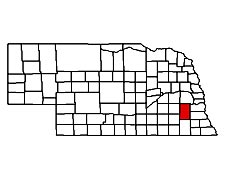Boreal Long-lip Tiger Beetle |
|
|
|
| |
|
|
 |
 |
| Cicindela longilabris longilabris Say |
| Adult Length: 13 to 17 mm |
| Appearance: This species is black to dark reddish brown dorsally and with maculation limited to one or two tiny humeral marks, a thin middle band, and a subapical dot. This species is distinct in that no other species recorded in Nebraska exhibits a middle band but entirely lacks an apical dot. Though rare, immaculate individuals may occur. |
| Similar Species: This species could be confused with C. nebraskana or C. duodecimguttata. It differs from C. nebraskana in luster, as C. nebraskana is very shiny black, whereas C. longilabris is dull (because of courser sculpturing). It differs from C. duodecimguttata in size, as it is much larger than C. duodecimguttata, and that the middle band in C. duodecimguttata is much more sharply bent. It is unlikely that this species would be encountered in most of Nebraska. |
| Biology: This species is an inhabitant of openings in boreal and transitional forests. It appears to be restricted to regions of high latitude or altitude. Adults can be found on sandy trails through pine, spruce, and aspen forests. They are quite skittish and the flight is straight and often for distances of over 60 m. |
| Adult Life History: Adults emerge from the pupa in August and remain active into September before overwintering. Activity resumes in May and June and peak numbers are reached from mid-June to early July. Numbers drop slowly and a few adults survive well into August. It is a spring-fall species. |
| Larval Life History: Eggs are laid mostly in June and July. Larvae normally reach the second instar by fall before overwintering. The third instar is reached the following summer before a second overwintering period. Pupation occurs during July of the following summer. |
| Biogeography: Though there are apparenly two specimens in the UNL collection from Lincoln, they are most likely mislabeled. The nearest known populations are in the Black Hills of South Dakota, the Colorado Rockies, and the northern Great Lakes. Even a dispersing individual would be highly unlikely. If this species were to occur in the state, it would be most likely in the Pine Ridge, but extensive surveys have yet to reveal it there. Mislabeled specimens are not rare, even in museum collections. Harold Willis once spoke of a specimen of C. patruela (a species that ranges west to central Minneota) labeled “ Walla Walla, WA”. Though it was certainly not collected there, its origin is not known. It was most likely collected near Walla Walla Creek in central Wisconsin. In North America this species is limited to regions of high latitude or altitude. It is a common species in much of Canada. It occurs from northern New England and Labrador across the northern Great Lakes and virtually all of Ontario north well into Alaska. It ranges southward in the mountains of the western United States to Arizona, New Mexico, and California. Three subspecies are currently recognized, but the taxonomy of this and its sister species, C. nebraskana is still somewhat unclear. |
|


